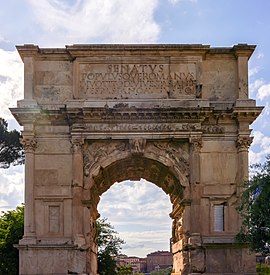
Back قوس تيتوس Arabic قوس تيتوس فى روما ARZ Трыумфальная арка Ціта Byelorussian Арка на Тит Bulgarian Arc de Titus Catalan Titův oblouk Czech Titusbogen German Αψίδα του Τίτου Greek Arco de Tito Spanish Titoren arkua Basque
 The Arch of Titus, showing the "Spoils of Jerusalem" relief on the inside arch | |
 Click on the map for a fullscreen view | |
| Location | Regio X Palatium |
|---|---|
| Coordinates | 41°53′26.5812″N 12°29′18.906″E / 41.890717000°N 12.48858500°E |
| Type | honorific arch |
| History | |
| Builder | Emperor Domitian |
| Founded | c. 81 A.D 1942–1943 years ago |
The Arch of Titus (Italian: Arco di Tito; Latin: Arcus Titi) is a 1st-century AD honorific arch,[1] located on the Via Sacra, Rome, just to the south-east of the Roman Forum. It was constructed in c. AD 81 by Emperor Domitian shortly after the death of his older brother Titus to commemorate Titus's official deification or consecratio and the victory of Titus together with their father, Vespasian, over the Jewish rebellion in Judaea.[2]
The arch contains panels depicting the triumphal procession celebrated in AD 71 after the Roman victory culminating in the fall of Jerusalem,[2] and provides one of the few contemporary depictions of artifacts from Herod's Temple.[3] Although the panels are not explicitly stated as illustrating this event, they closely parallel the narrative of the Roman procession described a decade prior in Josephus' The Jewish War.[4][5]
It became a symbol of the Jewish diaspora, and the menorah depicted on the arch served as the model for the menorah used as the emblem of the State of Israel.[6]
The arch has provided the general model for many triumphal arches erected since the 16th century. It is the inspiration for the Arc de Triomphe in Paris.[7] It holds an important place in art history, being the focus of Franz Wickhoff's appreciation of Roman art in contrast to the then-prevailing view.[8]
- ^ It was not a triumphal arch; Titus's triumphal arch was in the Circus Maximus.
- ^ a b "The Arch of Titus". exhibitions.kelsey.lsa.umich.edu. Archived from the original on 2017-11-05. Retrieved 2017-07-06.
- ^ The Menorah: From the Bible to Modern Israel, Steven Fine, 2016
- ^ Rocca, Samuele (2021-06-14). "Flavius Josephus and the Arch of Titus: Commemorating the Jewish War in Word and Stone". The Arch of Titus. BRILL. pp. 43–54. doi:10.1163/9789004447790_006. ISBN 9789004447790. S2CID 240655021. Archived from the original on 2023-03-26. Retrieved 2022-12-31.
- ^ DesRosiers, Nathaniel (2019-09-01). "Another Temple, Another Vessel: Josephus, the Arch of Titus, and Roman Triumphal Propaganda". Near Eastern Archaeology. 82 (3). University of Chicago Press: 140–147. doi:10.1086/704960. ISSN 1094-2076. S2CID 204473434.
- ^ Mishory, Alec. "Israel National Symbols: The State Emblem". Jewish Virtual Library. Archived from the original on 2014-07-17. Retrieved 2014-07-30.
- ^ Diana Rowell (23 August 2012). Paris: The 'New Rome' of Napoleon I. Bloomsbury Publishing. pp. 43–. ISBN 978-1-4411-2883-6.
- ^ Holloway, R. Ross. “SOME REMARKS ON THE ARCH OF TITUS.” L’Antiquité Classique, vol. 56, 1987, pp. 185. JSTOR, http://www.jstor.org/stable/41656878 Archived 2022-12-31 at the Wayback Machine. Accessed 31 Dec. 2022.
© MMXXIII Rich X Search. We shall prevail. All rights reserved. Rich X Search
